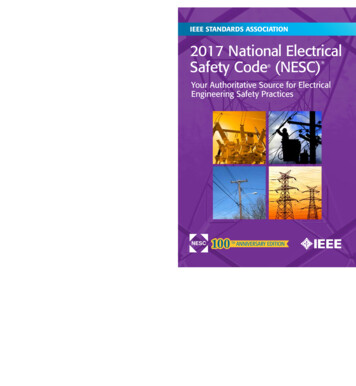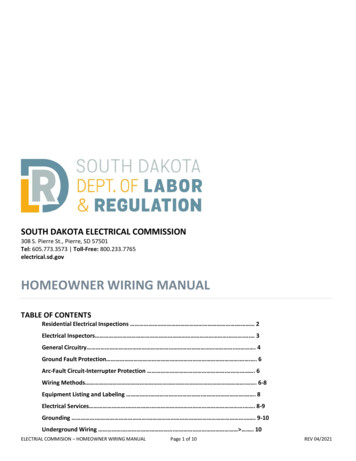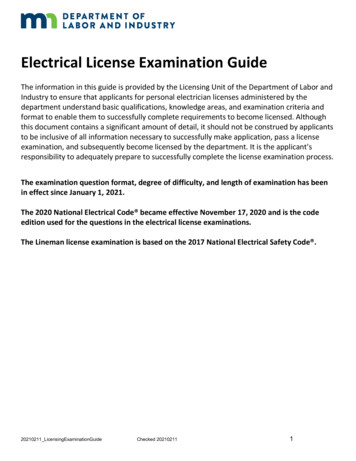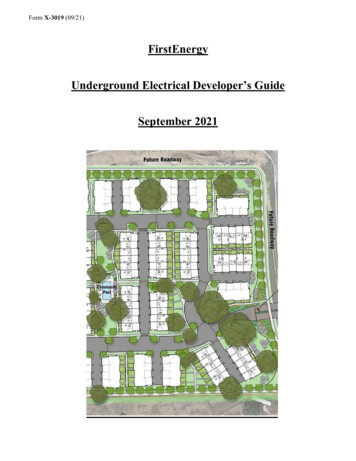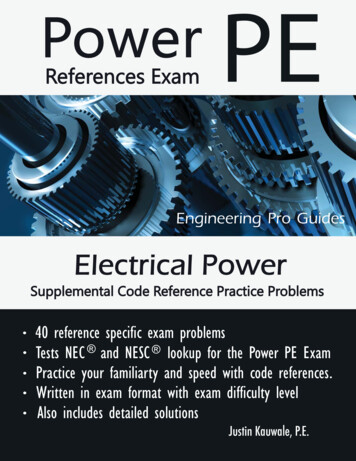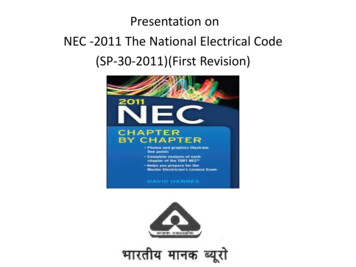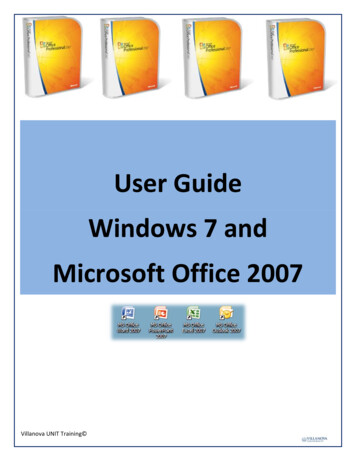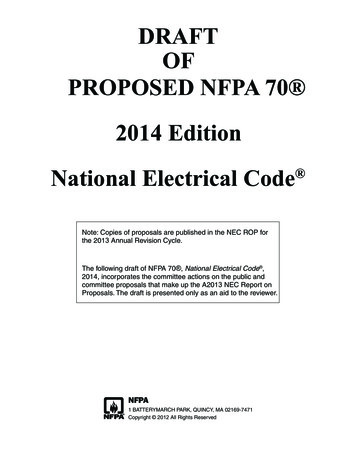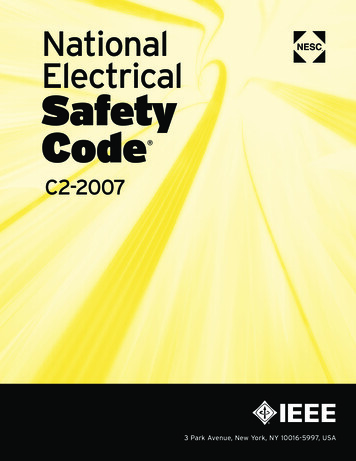
Transcription
NationalElectricalSafetyCode C2-2007 3 Park Avenue, New York, NY 10016-5997, USA
AccreditedStandardsCommitteeC2-2007National Electrical Safety Code SecretariatInstitute of Electrical and Electronics Engineers, Inc.Approved 20 April 2006Institute of Electrical and Electronics Engineers, Inc.Approved 16 June 2006American National Standards Institute2007 EditionAbstract: This standard covers basic provisions for safeguarding of persons from hazards arising from theinstallation, operation, or maintenance of (1) conductors and equipment in electric supply stations, and(2) overhead and underground electric supply and communication lines. It also includes work rules for theconstruction, maintenance, and operation of electric supply and communication lines and equipment. Thestandard is applicable to the systems and equipment operated by utilities, or similar systems and equipment,of an industrial establishment or complex under the control of qualified persons. This standard consists of theintroduction, definitions, grounding rules, list of referenced and bibliographic documents, and Parts 1, 2, 3,and 4 of the 2007 Edition of the National Electrical Safety Code.Keywords: communications industry safety; construction of communication lines; construction of electricsupply lines; electrical safety; electric supply stations; electric utility stations; high-voltage safety; operation ofcommunications systems; operation of electric supply systems; power station equipment; power stationsafety; public utility safety; safety work rules; underground communication line safety; underground electricline safetyThe Institute of Electrical and Electronics Engineers, Inc.3 Park Avenue, New York, NY 10016-5997, USACopyright 2006 by theInstitute of Electrical and Electronics Engineers, Inc.All rights reserved. Published 2006Printed in the United States of AmericaNational Electrical Safety Code and NESC are registered trademarks and service marks in the U.S. Patent &Trademark Office, owned by The Institute of Electrical and Electronics Engineers, Incorporated.The NESC logo is a trademark in the U.S. Patent & Trademark Office, owned byThe Institute of Electrical and Electronics Engineers, Incorporated.National Electrical Code and NEC are registered trademarks in the U.S. Patent & Trademark Office,owned by the National Fire Protection Association.ISBN 0-7381-4893-8Public authorities are granted permission to republish the materialherein in laws, regulations, administrative orders, ordinances, orsimilar documents. No other party may reproduce in any form, in anelectronic retrieval system or otherwise, any portion of this document,without the prior written permission of the publisher.1 August 2006SH95514
Recognized as anAmerican National StandardAn American National Standard implies a consensus of those substantially concerned with its scope andprovisions. An American National Standard is intended as a guide to aid the manufacturer, the consumer,and the general public. The existence of an American National Standard does not in any respect precludeanyone, whether he has approved the standard or not, from manufacturing, marketing, purchasing, orusing products, processes, or procedures not conforming to the standard. American National Standardsare subject to periodic review and users are cautioned to obtain the latest editions.
ForewordThis foreword is not a part of Accredited Standards Committee C2-2007, National Electrical Safety Code.This publication consists of the parts of the National Electrical Safety Code (NESC ) currently in effect.The former practice of designating parts by editions has not been practical for some time. In the 1977Edition, Parts 1 and 4 were 6th editions; Part 2 was a 7th edition; Part 3 was a revision of the 6th edition;Part 2, Section 29, did not cover the same subject matter as the 5th edition; and Part 3 was withdrawn in1970. In the 1987 Edition, revisions were made in all parts, and revisions to all parts have been made insubsequent editions. It is therefore recommended that reference to the NESC be made solely by the year ofthe published volume and desired part number. Separate copies of the individual parts are not available.Work on the NESC started in 1913 at the National Bureau of Standards (NBS), resulting in the publicationof NBS Circular 49. The last complete edition of the Code (the 5th edition, NBS Handbook H30) was issuedin 1948, although separate portions had been available at various times starting in 1938. Part 2—Definitions,and the Grounding Rules, 6th edition, was issued as NBS Handbook H81, ANSI C2.2-1960, in November1961, but work on other parts was not actively in process again until 1970.In 1970 the C2 Committee decided to delete the Rules for the Installation and Maintenance of ElectricUtilization Equipment (Part 3 of the 5th edition), now largely covered by the National Electrical Code (NEC )(NFPA 70, 2005 Edition), and the Rules for Radio Installation (Part 5 of the 5th edition) from futureeditions. The Discussion of the NESC, issued as NBS Handbook H4 (1928 Edition) for the 4th edition of theNESC and as NBS Handbook H39 for Part 2 of the Grounding Rules of the 5th edition, was not publishedfor the 6th edition.The 1981 Edition included major changes in Parts 1, 2, and 3, minor changes in Part 4, and the incorporationof the rules common to all parts into Section 1. The 1984 Edition was revised to update all references and tolist those references in a new Section 3. Converted metric values, for information only, were added. Genderrelated terminology was deleted. Section 1—Introduction, Section 2—Definitions, Section 3—References,and Section 9—Grounding Methods, were made applicable to each of the Parts 1, 2, 3, and 4.The 1987 Edition was revised extensively. Definitions were changed or added. Requirements affectinggrounding methods, electric supply stations, overhead line clearances and loading, underground lines, andwork rules were revised.The 1990 Edition included several major changes. General rules were revised. A significant change to themethod for specifying overhead line clearances was made and the rationale added as Appendix A.Requirements for clearances of overhead lines from grain bins and an alternate method for determining thestrength requirements for wood structures was added. Rules covering grounding methods, electric supplystations, underground lines, and work rules were changed.In the 1993 Edition, changes were made in the rules applicable to emergency and temporary installations. InSection 9 and Parts 1, 2, and 3, rules were extended or clarified to include HVDC systems. The requirementsfor random separation of direct-buried supply and communications systems were modified for consistencyand clarity, as was the rule in Part 4 on tagging electric supply circuits.In the 1997 Edition, the most notable general change that took place is that numerical values in the metric(SI) system are shown in the preferred position, with customary inch-foot-pound values (inside parentheses)following. A bibliography, Appendix B, which consists of a list of resources identified in notes orrecommendations, was added. Changes were made to rules affecting grounding, electric supply stations, andoverhead lines, particularly with regard to clearance rules applicable to emergency and temporaryinstallations. Strength requirements contained in Sections 24, 25, and 26 were revised completely.Copyright 2006 IEEE. All rights reserved.iii
Underground line requirements for random separation for underground lines of direct-buried cables weremodified. The requirement for cable identification marking by means of sequentially placed logos wasintroduced. Work rules added a requirement that warning signs and tags comply with applicable ANSIstandards, tagging requirements were clarified with regard to SCADA, and extensive requirements for fallprotection were added.In the 2002 Edition, several changes were made that affected all or several parts of the Code. Particularly,this edition clarifies interfaces between the NEC and NESC with regard to Code jurisdiction in the area ofstreet lights and area lights. Also included is clarification for situations between utility workers and theirauthorized contractors and installations on industrial complexes.The major revisions for the 2007 Edition include grounding, moving sag calculations to Section 23, movingguy and span wires insulator rules to Section 21, phasing out of the alternate method for load factors andstrength factors, flammable materials transported, phase-to-phase cover-up, and minimum approachdistance tables.Subcommittee 1 concerned itself with assuring continuity between subcommittees and supervising theaddition of definitions and references. Definitions included work on ducts, conduits, conduit systemsraceways, overvoltage/transient conditions, shield wires/static wires, flashover/sparkover, sag, creep, readilyclimbable/not readily climbable, and others. Inspection and work rules as related to Rule 13 were clarified.The extensive changes made by Working Group 4.10 on overhead clearances was reviewed and accepted forinclusion in Section 23 as well as in a new Appendix B to the Code. A similar review of the work bySubcommittee 5 led to creation of new Appendix C to cover application of extreme wind loading covered inRule 250C.Section 9—Based on extensive studies, steel poles are now permitted as grounding electrodes, and Rule 97Gmandates common bonding between communication and power grounding electrodes, with additionalinformation on common bonding given in Rule 99. Metallic water piping systems are no longer a preferredgrounding electrode. Changes to Rule 96 clarify ground resistance requirements, and changes to Rule 94Bclarify dimensional requirements for ground rods.Part 1—Selected column headings have been revised for clarity, and inconsistencies in Tables 124-1 and125-1 corrected.Part 2—Overhead clearances. A new approach for calculating clearances is detailed in new Section 23 andAppendix B. Rules related to sag calculation for conductor sags as related to clearances were moved fromSections 25 and 26 (loading and strength) into sections covering clearances. All calculations in which bothloaded and unloaded conductors involving ice and wind when used for strength calculations remain inSections 25 and 26. Rule 215C2 was revised to require all guys regardless of exposure to be insulated orgrounded. Rules related to guy and span wire insulators moved from Rule 279 to Rule 215C2 to improvesubject matter retrieval from the Code. The vertical clearance of a service drop attached to a mast, porch,deck, or balcony has been increased from 2.45 to 3 m (8 to 10 ft). Rule 235G has been changed to allowmultiplex line cable up to 750 V to attach to the same support bracket as neutral conductors meetingRule 230E1.Part 2—Strength and loading. No modifications were made to Rule 250C to remove the exemption thatexcludes structures of less than 18 m (60 ft) height from having to meet the extreme wind requirements. Theefficacy of doing so will be considered again for the 2012 Edition. Insulator strength ratings and conductortensions are scheduled for study with possible changes to the 2012 Edition. Specific load factors in Tables253-1 and 253-2 have been reduced. Tables 253-2 and 261-1B covering alternate load factors and strengthfactors, respectively, will be phased out in July 2010. They will be replaced by Tables 253-1 and 261-1Athat are applicable to all materials. Load and strength factors have been specified for fiber reinforced plastic(FRP) materials, and strength factors for FRP structures, crossarms, and braces have been added. Rules250A, 253, and 261N have been made more specific in dealing with construction maintenance loads.ivCopyright 2006 IEEE. All rights reserved.
Rule 261A2e, which permitted poles of reduced strength to remain in service under the specific condition ofbeing supported by stronger poles on each side of the pole, has been removed. In the long-term view, poledesign is tending to move in the direction of Probabilistic Design (LRFD) away from Deterministic Design,a trend which is in concert with a majority of other industries.Part 3—Rule 311C was added to permit supply and communication cables to be laid directly on grade,providing they do not obstruct traffic or pedestrians and meet other applicable rules. Rule 351C1 wasclarified to better describe the limitations of where aboveground pools may be located relative to supplycable, and also state the rule that applies to aboveground pools. It is now recognized that all flammablematerial transported in pipelines is under some conditions considered hazardous because of location. TheCode now requires the same radial separation of 300 mm (12 in) for supply and communication cables fromall lines that transport flammable material, not only fuel lines. The rule now defines a flammable liquid.Part 4—Work revolved largely around expanding guidelines for use of fire resistant (FR) clothing and othersafety equipment such as voltage protection devices. These guidelines include arc hazard analysis andreference tables. A new rule was introduced to address high-frequency radiation effects on workers in boththe supply and communications spaces arising from communication antennas mounted in those spaces. Anew rule requiring phase-to-phase cover-up when guarding against phase-to-phase contact was added.Changes were made to existing minimum approach distance tables. These distances agree with thosepublished in IEEE Std IEEE 516 .qSubstantive changes in the 2007 Edition are identified by a bar in the left-hand margin. In several cases,rules have been relocated without substantive changes in the wording. In these cases, only the rule numbershave been indicated as having been changed.The Institute of Electrical and Electronics Engineers, Inc., was designated as the administrative secretariatfor C2 in January 1973, assuming the functions formerly performed by the National Bureau of Standards.Comments on the rules and suggestions for their improvement are invited, especially from those who haveexperience in their practical application. In future editions every effort will be made to improve the rules,both in the adequacy of coverage and in the clarification of requirements. Comments should be addressed to:SecretaryNational Electrical Safety Code CommitteeInstitute of Electrical and Electronics Engineers, Inc.445 Hoes LaneP.O. Box 1331Piscataway, NJ 08855-1331A representative Interpretations Subcommittee has been established to prepare replies to requests forinterpretation of the rules contained in the Code. Requests for interpretation should state the rule in question,as well as the conditions under which it is being applied. Interpretations are intended to clarify the intent ofspecific rules and are not intended to supply consulting information on the application of the Code. Requestsfor interpretation should be sent to the address above.If the request is suitable for processing, it will be sent to the Interpretations Subcommittee. Afterconsideration by the committee, which may involve many exchanges of correspondence, the inquirer will benotified of its decision. Decisions are published regularly and may be ordered or accessed online at no costat http://standards.ieee.org/nsec.The NESC as written is a voluntary standard. However, some editions and some parts of the Code have beenadopted, with and without changes, by some state and local jurisdictional authorities. To determine the legalqInformation on references can be found in Section 3.Copyright 2006 IEEE. All rights reserved.v
status of the NESC in any particular state or locality within a state, the authority having jurisdiction shouldbe contacted.The revision cycle for the 2012 Edition of the NESC will be fully electronic. Change proposals andcomments will be submitted to the NESC Secretary online via the Internet. For information on how thiselectronic revision process will take place and for updates and complete information on the NESC, pleasevisit the National Electrical Safety Code Zone on the IEEE Standards Web site at http://standards.ieee.org/nesc.viCopyright 2006 IEEE. All rights reserved.
Standards Committee MembershipAt the time this Code was approved, Accredited Standards Committee C2 had the following membership:O. Chuck Amrhyn, ChairFrank A. Denbrock, Vice ChairWilliam A. Ash, SecretaryOrganization RepresentedNameAlliance for Telephone Industry Solutions . Lawrence M. SlavinAmerican Insurance Services Group, Inc. . VacantAmerican Public Power Association . Michael J. HylandNathan Mitchell (Alt.)American Public Transit Association . VacantAssociation of American Railroads . VacantAssociation of Edison Illuminating Companies . Doug MaderBilly Raley (Alt.)Bonneville Power Administration, US Department of Energy.Jerry L. RedingCanadian Standards Association Liaison Representative . David SingletonEdison Electric Institute . David G. KomassaJohn W. Troglia (Alt.)Electronic Industries Association .Percy E. PoolJoseph Muccilo (Alt.)Independent Electrical Contractors.James C. TuggleRobert W. Baird (Alt.)Institute of Electrical and Electronics Engineers, Inc.Frank A. DenbrockVernon R. Lawson (Alt.)International Association of Government Labor Officials . VacantInternational Brotherhood of Electrical Workers .James R. TomaseskiInternational Municipal Signal Association.Warren FarrellNational Association of Regulatory Utility Commissioners . VacantNational Cable & Telecommunication Association . Rex BullingerChristopher Austin (Alt.)Steve Mace (Alt.)National Electrical Contractors Association .O. L. DavisBrooke H. Stauffer (Alt.)National Electrical Manufacturers Association . Vincent BaclawskiNational Rural Electric Cooperative Association .Robert D. SaintMichael C. Pehosh (Alt.)National Safety Council.Jeff ClarkNational Society of Professional Engineers.William F. FullerRural Utilities Service, US Department of Agriculture .Robert LashSociety of Cable Telecommunications Engineers .Alan AmatoTimothy Cooke (Alt.)Tennessee Valley Authority .Clayton L. ClemStephen Cantrell (Alt.)Western Area Power Administration, US Department of Energy . VacantIndividual Member .O. Chuck AmrhynIndividual Member .Allen L. ClappLiaison Representative to Canadian Electrical Code.Susan L. VogelCopyright 2006 IEEE. All rights reserved.vii
Subcommittee 1Purpose, Scope, Application, Definitions, and References(Sections 1, 2, and 3)Allen L. Clapp, ChairO. Chuck AmrhynCharles C. BleakleyJohn C. SpenceD. J. ChristofersenGary R. EngmannJohn B. DagenhartEwell T. RobesonCharles C. Bleakley, ank A. DenbrockAllen L. ClappDonald E. HooperDavid G. KomassaEric K. EngdahlJames R. TomaseskiJ. David 8)(Alt.)Subcommittee 2Grounding Methods(Section 9)John B. Dagenhart, ChairJ. BoksinerHarvey L. BowlesA. C. ChannaiahKeith ReeseJohn B. DagenhartM. M. DixonL. E. GauntWilliam J. TurnerN. MaxwellEwell T. Robeson, Robert MoldeMichael A. MoorePercy E. PoolJoseph MucciloEwell T. RobesonRobert D. SaintMichael C. PehoshJames R. TomaseskiDonald W. ittee 3Electric Supply Stations(Sections 10–19)D. J. Christofersen, ChairD. J. ChristofersenA. L. ComansW. Bruce DietzmanGary R. EngmannKeith C. HarrisonRobert D. SaintS. J. KollmannBrian WinoskiGary R. Engmann, �Association of American RailroadsAEIC—Association of Edison Illuminating CompaniesAISG—American Insurance Services Group, Inc.AISI—American Iron and Steel InstituteAPPA—American Public Power AssociationAPTA—American Public Transit AssociationATIS—Alliance for Telephone Industry SolutionsAWPA—American Wood Preserves AssocationBPA—Bonneville Power Admin., US Dept. of EnergyEEI—Edison Electric InstituteEIA—Electronic Industries AssociationIAGLO—Int’l. Assoc. of Government Labor OfficialsviiiMark A. KonzChristopher A. CarsonRobert E. Sipler, Jr.James R. TomaseskiPhilip YoungGeorge l Brotherhood of Electrical WorkersIEEE—Institute of Electrical and Electronics Engineers, Inc.IMSA—International Municipal Signal AssociationNARUC—National Association of Regulatory Utility CommissionersNCTA—National Cable Television AssociationNECA—National Electrical Contractors AssociationNEMA—National Electrical Manufacturers AssociationNSC—National Safety CouncilNSPE—National Society of Professional EngineersRUS—Rural Utilities Services, US Dept. of AgricultureSEEX—Southeastern Electric ExchangeTVA—Tennessee Valley AuthorityWAPA—Western Area Power Administration, US Dept. of EnergyCopyright 2006 IEEE. All rights reserved.
Subcommittee 4Overhead Lines—Clearances(Section 20, 21, 22, and 23)David G. Komassa, ChairEric K. Engdahl, SecretaryO. Chuck AmrhynChris AustinRex BullingerSteve MaceR. J. BednarzCharles C. BleakleyKeith ReeseJames. L. BohlkAllen L. ClappCharles CrawfordThomas R. CrowellPhillip S. GivensKevin DrzewieckiChris Ann ShellergEric K. EngdahlTracy DenckerMickey B. GunterAndrew MetrickDennis HenryTrevor BowmerDonald E. fJan HowardH. N. Johnson, Jr.Joseph J. WhiteDavid G. KomassaDavid J. MarneErnest H. NeubauerMichael C. PehoshRobert G. OswaldOliver W. PerkinsJerry L. RedingJoseph RenowdenJames RuehlMathew C. SchwarzLawrence M. SlavinR. H. StevensJames R. TomaseskiB. J. WashburnAlan T. YoungJoseph MucciloDavid C. mittee 5Overhead Lines—Strength and Loading(Sections 24, 25, 26, and 27)Frank A. Denbrock, ChairJulian AjelloAlan J. AmatoTed S. WooNelson G. BingelRex BullingerChris AustinSteve MaceJohn BuselBrian LacoursiereDaniel LonerganJim ByrneMichael C. PehoshHelen ChenRichard AichingerAllen L. ClappClayton L. ClemFrank A. DenbrockBruce FreimarkRobert S. FullerDouglas HansonTerry BurleyCopyright 2006 IEEE. All rights reserved.Allen L. Clapp, APA(Alt.)Edward HarrelDonald G. HealdRobert LashRichard W. HenselWalter D. JonesLeon Kempner, Jr.Jim KinghornJacob JoplinRobert O. KlugeJoseph MucciloAlan T. YoungRobert C. PetersJoseph RempeAndrew SchwalmWade ShultzRon CorzineLawrence M. SlavinRichard J. StandfordJose L. VivasJerry C. IEEEAPPAIEEESEEX(Alt.)ATISEEIEEIEEIix
Subcommittee 7Underground Lines(Sections 30–39)Charles C. Bleakley, ChairAlan J. AmatoO. Chuck AmrhynChris AustinSteve MaceRex BullingerCharles C. BleakleyMickey B. GunterMichael L. DyerR. A. FernandezPercy E. PoolLauren E. GauntDennis HenryTrevor BowmerTrung HiuJohn C. Spence, (Alt.)EEIATIS(Alt.)RUSDavid H. KendallJames D. MarsAndrew MetrickDennis B. MillerMichael C. PehoshRobert D. SaintGeorge S. PristachEwell T. RobesonLawrence M. SlavinJohn C. SpenceMonte SzendreJames R. TomaseskiRichard VencusTed S. WIEEESCTESubcommittee 8Work Rules(Sections 40–44)James R. Tomaseski, ChairWayne P. BlackleyF. M. BrooksKenneth BrubakerMark ZavislanJ. F. DoeringBrian ErgaRobert A. FassMaury DunnMichael GranataC. W. GroseDennis HenryTrevor BowmerEdward HuntHenry J. KientzJeffrey WildBrent McKinneyJ. D. MitchellThomas VerdecchioJ. David Mitchell, lfATIS(Alt.)WAPASelf(Alt.)APPAIEEE(Alt.)Stephen PoholskiThomas RyderLawrence SchweitzerAlbert SmoakSamuel StonerockSteven TheisJames R. TomaseskiGene TootleDavid J. NagyD. M. WallisJeffery A. WhiteWilliam C. WeintrittChuck WoodingsJames C. TuggleRobert W. Alt.)IEC(Alt.)(Alt.)Executive SubcommitteeO. Chuck Amrhyn, ChairO. Chuck AmrhynFrank A. DenbrockMichael J. HylandFrank A. Denbrock, Vice ChairSelfIEEEAPPALeon KempnerLawrence M. SlavinJames R. TomaseskiBPAATISIBEWJennie M. SteinhagenIEEE Standards Project EditorxCopyright 2006 IEEE. All rights reserved.
Interpretations SubcommitteeDonald E. Hooper, ChairO. Chuck AmrhynR. J. BednarzCharles C. BleakleyD. J. ChristofersenAllen L. ClappJohn B. DagenhartO. L DavisFrank A. DenbrockGary R. EngmannEmerson W. GlancyCharles W. GroseAAAP1AP2, S9P3AP1AP4Mickey B. GunterDonald E. HooperHerman N. Johnson, Jr.Henry J. KientzRobert G. OswaldPercy E. PoolWayne B. RoelleLanny L. SmithJames R. TomaseskiDavid C. YoungP2, P3AAP4P2P3, S9P2AAAA All areas, P1 Part 1, P2 Part 2, P3 Part 3, P4 Part 4, S9 Section 9Copyright 2006 IEEE. All rights reserved.xi
ContentsSectionPageContentsSectionPageLetter symbols for units . xxxiiiSec. 1. Introduction to the National Electrical Safety Code .1010. Purpose.1011. Scope. 1012. General rules . 1013. Application. 1A. New installations and extensions . 1B. Existing installations . 2014. Waiver. 2A. Emergency installations. 2B. Temporary overhead installations . 2015. Intent . 2016. Effective date . 3017. Units of measure . 3018. Method of calculation . 4Sec. 2. Definitions of special terms . 5Sec. 3. References . 5Sec. 9. Grounding methods for electric supply and communications facilities090. Purpose. 17091. Scope. 17092. Point of connection of grounding conductor .
The Institute of Electrical and Electronics Engineers, Incorporated. National Electrical Code and NEC are registered trademarks in the U.S. Patent & Trademark Office, owned by the National Fire Protection Association. ISBN 0-7381-4893-8 Public authorities are File Size: 2MBPage Count: 373

